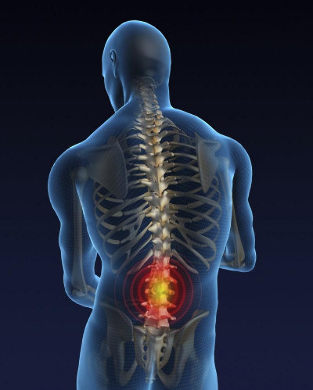In some cases, the patient may be difficult to straighten in the standing position. The sharp pain in the back can last from a few days up to several weeks.

The causes of acute pain in the lower back
Most people, at least once in life have experienced back pain. Although the pain or discomfort can appear in any level, often precisely addressed the lumbar region. This occurs because the spine forced to endure the weight of the entire body and the head.
Back pain is the second occasion to have recourse to a doctor, behind colds and the flu.
As a general rule, for the first time, the acute pain in the lower back appears after lifting heavy object, a sudden movement, injury or long in the same posture.
The acute pain in the lower back, often, is the result of a sudden, the traumatisation of the muscles and ligaments of the back, herniated lumbar disc of the vertebral column. The pain, in these cases, it may be due to muscle spasm, stretching or rupture of the muscles and ligaments.
The causes of the court of back pain are:
- compression fractures of the vertebrae due to injury or osteoporosis;
- a muscle spasm (excess muscle tension);
- the hernia;
- the sciatica;
- stenosis (narrowing) of the spinal canal);
- the curvature of the spine (e.g. scoliosis or kyphosis) including the illness of The president of the Mau;
- traction/tear of the muscles or ligaments of the back;
- spondylosis;
- spondylolisthesis;
- infection of the spine (discitis, abscess.
A sharp pain in the lower back may also cause the following systemic diseases:
- diffuse connective tissue disease;
- the disease behtereva;
- a malignant tumor of the spine;
- the rheumatoid arthritis.
The causes of acute pain in the lower back, not related to problems in the spine or the tissues of the back:
- aneurysm of the abdominal aorta;
- gastrointestinal disease: pancreatitis, stomach ulcer, cholecystitis;
- the herpes zoster;
- disease pelvic: endometriosis, prostatitis, inflammation of the pelvis;
- the disease of retroperitoneum: renal colic, pyelonephritis;
- pregnancy.
The symptoms of the
The symptoms of acute pain in the lower part of the back vary considerably depending on their causes. You may feel numbness, tingling, the nature of the pain can be different, as well as the intensity of pain, from mild discomfort to pain, that you can barely withstand. In addition, back pain is often combined with pain in the leg, the hip, the foot. In some cases, you may receive the weakness in the leg.
Here are some examples of the characteristic symptoms of the different diseases and conditions:
- when intervertebral hernia: pain in the lower back, often in the leg, and the pain in the leg sharp pain in the back and is exacerbated in the sitting position or after sleep. Lower back pain can be given in the buttock, thigh and down the leg to the foot. May experience a sensation of tingling, numbness in the leg and the toes of the feet, in rare cases, weakness of the muscles of the legs;
- the traction of the muscles of the back: diffuse pain in the lower part of the back, which is not given in the leg or in the buttock; intensifies with movement, and is weakened in the resting state;
- when stenosis of the spinal canal: pain in the lower back and the leg, and the pain in the leg sharp pain in the lower back, as well as spinal stenosis, often accompanied by the development of an intervertebral hernia; worsens in the standing position and when walking, it weakens and resting on the bent back. The pain may be unilateral and bilateral;
- when diffuse disease of connective tissue: pain in several joints, fever, weight loss, weakness;
- when osteomyelitis: constant pain, often normal temperature; clinical analysis of blood in the standard, the increase of the erythrocyte sedimentation rate (esr) and/or the level Of c-reactive protein.
The diagnosis
In the consultation the doctor will perform a conversation with the patient, asking questions about the nature and severity of the pain and other symptoms, collect information about the background and perform a medical examination. From the data of interviews and the examination, the doctor may make a diagnosis, or preliminary diagnosis, which should confirm or clarify with the help of medical tests. The medical tests may be different from the analysis of blood and even nerve conduction studies. Most popular from the survey include:
X-ray of

The x-ray is performed to evaluate the state of bone tissue of the patient. The diagnosis that can be supplied through an x-ray, which include osteoporosis, compression fracture, and bony expansion of osteophytes);
Magnetic resonance imaging magnetic resonance imaging (mri)
The advantage of the rm before the other studies is that, through magnetic resonance imaging can produce detailed images of high quality not only the bone but also of soft tissues: muscles, ligaments, blood vessels, nerves, intervertebral discs, spinal cord, etc
More frequent diagnosis of findings of magnetic resonance imaging:
- intervertebral hernia;
- the narrowing (stenosis) of the spinal canal;
- spondylitis.
Other diagnostics that can be put on with the help of magnetic resonance imaging:
- ankylosing spondylitis (type of arthritis);
- the infection of the bones;
- the syndrome of the tail of a horse;
- compression fractures;
- discitis (inflammation of the intervertebral disc);
- the abscess of the spinal cord;
- injuries of the spinal cord;
- the tumor in the spine.
The computed tomography (ct)
Computed tomography also allows to obtain the image not only bone but also of soft tissues, however, the image quality, very inferior to the quality of the photographs, obtained during the realization of a magnetic resonance imaging, therefore, ct is recommended in the case of performing an mri scan, for some reason it is not possible or is difficult, for example, if you have a pacemaker or metal structures in the body.
The treatment of the
That can be done at home with sharp pain in the lower back?
- the limitation of the physical activity in 1-2 days. This will help to relieve the symptoms and reduce the inflammation in the painful area;
- the grip of the bags of hot water or a bubble of ice to the painful area;
- the reception without a prescription for pain medication. Not worth taking these medications in greater amounts than is stated in the instructions, take medications, you should not more than 3 days. If the pain does not go away - you should consult a doctor.
During sleep, it is better to accept the position of the embryo and put a pillow between the legs. If you're used to sleeping on your back, place a pillow under the knees, or a stack of towel to remove the load in the back.
If the cause of back pain is more severe, then the patient requires a specific treatment, depending on the illness or condition that caused the sensation of pain, and here you can already do without the help of a specialist.
One of the most common causes of acute pain in the lower back, which needs a special treatment, it is intervertebral hernia. The treatment intervertebral hernia, as a general rule, conservative, only once in a while to the doctors to resort to surgical methods. There are a large number of conservative treatment options intervertebral hernia. Here's just some of them:
- The pharmacological treatment. The pharmacological treatment includes the reception of the analgesic and anti-inflammatory.
- Apply traction to the spine. What is applying traction does not lead to complications, in comparison with traction on the tables with the phasor of the load or goods. Apply traction of the spine in part to restore the power and, as a result, the state of the intervertebral discs and helps reduce the size of intervertebral hernia;
- The massage therapy. Types of therapies and massages are very different. In general, this method aims to achieve relaxation of the muscles of the back, the removal of muscle spasms, which often accompany the pain in the lower back;
- Gymnastics. Gymnastics focuses on the strengthening of the small muscles of the back;
- Hirudotherapy
Hirudotherapy relieves the inflammation around the hernia, reduces the pain syndrome. It is an alternative to the anesthesia medications. - The surgical treatment. The surgical treatment of intervertebral hernia is only recommended to patients who do not help the conservative treatment of the media, always and when this treatment was carried out periodically and systematically, and in patients who have begun treatment with symptoms expressed neurological deficit: weakness in leg, paresis, paralysis of the legs, numbness in the groin area, the violation of control over the functions of urination and/or defecation. All these symptoms are the indications for the urgent implementation of the operation on the spine.

























